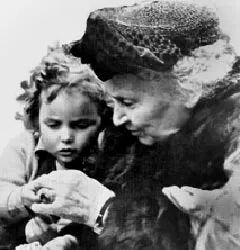Part 1: Maria Montessori: Groundbreaker, Method Maker
Breaking New Ground

The year was 1894 and 25-year-old Maria Montessori had just become Italy’s first female physician and surgeon. Though young, Maria had already accomplished many firsts for a woman. When she was twelve years old, Maria was the only girl to attend the technical school where she studied mathematics. As a teenager, she studied engineering, another all-male area of education. Her initial application to the University of Rome’s medical program was turned down because of her gender, but Maria persevered. She took additional classes and continued to apply until, at last, the medical school accepted her into their program.
After earning her medical degree, Maria began research at the University of Rome's psychiatric clinic. There, she met the clinic’s youngest patients. Several children labeled as “deficient and insane,” spent their days in the clinic’s bleak rooms. There was not much for them to do, or look at, or play with. Ever the scientist at heart, Maria carefully observed and studied these children. She soon discovered that what these children needed above all was mental and sensorial stimulation. She began to develop learning materials for these children. Two years later, many of these so-called deficient children could read, write, and do mathematics at levels comparable with “normal” children their age.
Inspired by this initial success, Maria continued her enthusiastic studies of educational theory and child development. In 1907, she was offered an opportunity to run a childcare facility in an impoverished part of Rome. Much to the amazement of her medical colleagues, Maria accepted the challenge. Combining her years of scientific study with her keen observations of children, Maria developed a whole new approach to education. Unlike any existing educational methods, Maria’s approach maximized the child’s innate desire to learn. Her new approach became known as The Montessori Method.
Montessori Classroom

The Method
Maria Montessori’s educational method started with a carefully prepared environment. Based on her insights into the way children really learn, Maria developed hands-on materials that appeal to, and correspond with the child’s developmental stages.
Maria discovered that children under the age of six have amazingly absorbent, sponge-like minds. They soak in information quickly and effortlessly. Within this “absorbent mind” stage, children also experience intense physical, mental, and emotional bursts of growth, which Maria called “sensitive periods.” During a sensitive period, the child can grasp certain concepts more easily and naturally than at any other time.
Children are instinctively drawn toward specific activities that satisfy these sensitive periods. The Montessori Method maximizes the child’s potential by providing carefully selected and relevant materials, and then allowing the child to choose materials based on their own inner impulses. By letting children choose the right activity at the right time, the Montessori Method takes full advantage of the child’s inherent desire to learn. If these important windows of opportunity are missed, the concepts become significantly more difficult for the child to learn.
"Education cannot be effective unless it helps a child to open up himself to life.”

“We cannot know the consequences of suppressing a child’s spontaneity when he is just beginning to be active. We may even suffocate life itself. That humanity which is revealed in all its intellectual splendor during the sweet and tender age of childhood should be respected with a kind of religious veneration. It is like the sun which appears at dawn or a flower just beginning to bloom. Education cannot be effective unless it helps a child to open up himself to life.” - Dr. Maria Montessori
To be continued in Part 2, Maria Montessori: Groundbreaker, Method Maker




















